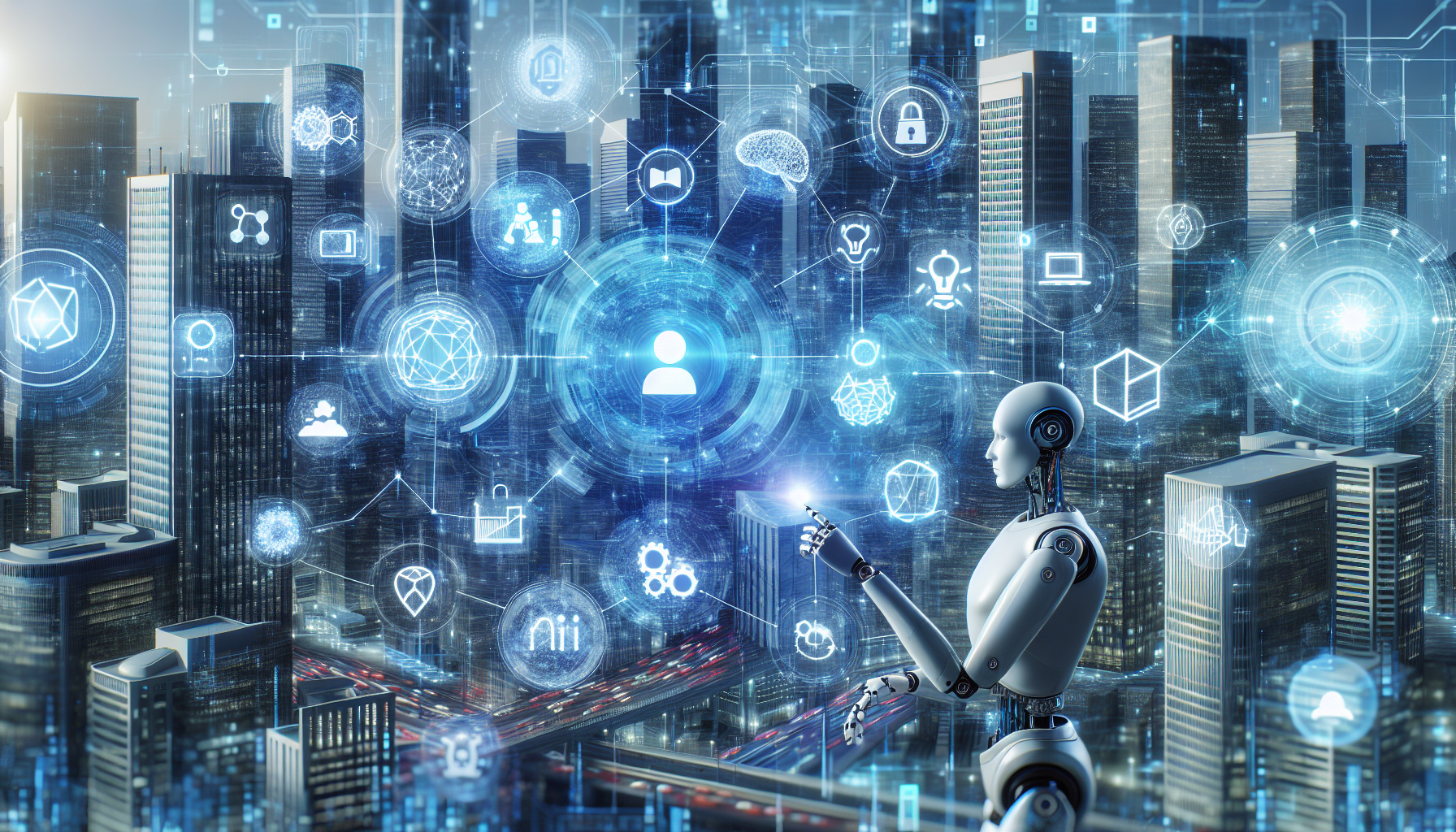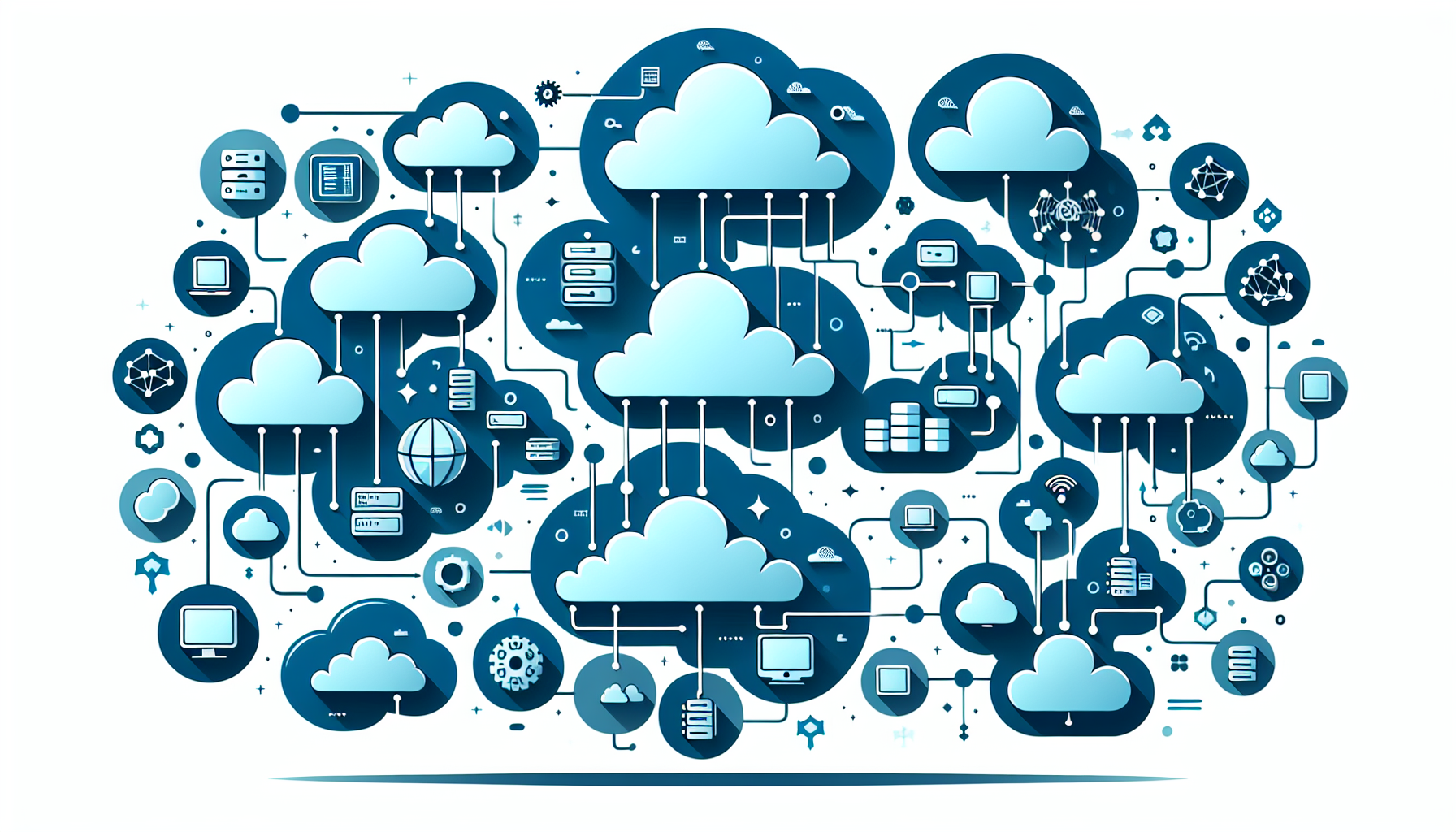As 2024 approaches, discerning which software development technologies will lead the charge is critical for professionals poised to stay ahead. Eliminating fluff, this guide zeroes in on the best software development technologies 2024 has to offer, equipping you with insights about transformative tools and trends from AI advancements to cloud computing and edge computing that will dictate tomorrow’s software landscape.
Key Takeaways
- AI and Machine Learning are influencing software development through technologies like TensorFlow and AutoML, enhancing capabilities in NLP, predictive analytics and automating development processes.
- Cloud computing including serverless architectures, cloud-native technologies, and hybrid cloud strategies are leading the charge in transforming the software deployment and development methodologies, with substantial savings in cost and increase in scalability.
- Emerging technologies like Progressive Web Apps, Blockchain, Edge Computing, VR/AR and Quantum Computing are carving out new paths, showcasing transformative potential in various industries from retail to data science.
Cutting-edge AI and Machine Learning Frameworks

As the software development space advances, Artificial Intelligence (AI) and Machine Learning (ML) are becoming increasingly important. Python is now the second most popular programming language. Illustrating how AI/ML has grown in relevance as a result of its quick prototyping capabilities for creating faster apps. Predicted growth of 34% year on year shows that these technologies will continue to be major trends by 2024.
TensorFlow’s AutoML tool provides extra features while making machine learning more user-friendly with automated processes that simplify software creation – influencing all areas including natural language processing, predictive analytics, plus artificial intelligence powered platforms too!
Natural Language Processing Breakthroughs
Innovations in AI and machine learning have been especially noteworthy when it comes to Natural Language Processing (NLP), which allows computers to interpret human language, transforming our relationship with machines. Leaders such as Amazon, Kate Crawford, and Christopher D. Manning are helping pave the way for more sophisticated software solutions like chatbots, voice assistants and text analysis technologies that make use of transformer-based models and other advanced ML techniques. This emerging field promises a whole new realm of opportunities for enterprise software development well into the future.
Predictive Analytics Powerhouse Tools
The recent surge of Predictive Analytics Powerhouse Tools using AI and machine learning has made a significant impact on the software development lifecycle. By automating analysis, predicting trends and recognizing patterns based on historical data from tools such as Alteryx, Oracle Azure ML, IBM SPSS or H2O Driverless AI, operational efficiency can be improved for better customer experiences that anticipate their needs before they are aware of them. This enables forecasting customers’ behavior to optimize resource utilization more effectively too.
AI-Driven Development Platforms
The software development industry is undergoing an evolution as AI-Powered Development Platforms automate certain processes and tasks. Organizations such as GitHub Copilot, Mintlify and Tabnine are spearheading this transformation by providing platforms which optimize the selection of machine learning models along with their parameters to improve code quality while shortening timeframes for releases.
For instance, in both financial and customer engagement systems like Medallia, coding workload has decreased drastically thanks to these AI integrated environments thus reflecting its potential advantages.
Pioneering Cloud Computing Solutions

The digital era has seen the emergence of cloud computing as one of its most prominent software development trends. According to BairesDev, it is projected that this focus on clouds will remain a major trend even in 2024.
Serverless architectures, hybrid cloud strategies and other such solutions offered by cloud computing are transforming how applications are developed, implemented and maintained – providing numerous advantages including scalability, cost effectiveness and flexibility for companies undergoing digital transformations.
Serverless Architectures
Software developers have embraced cloud computing, in particular serverless architecture, to revolutionize how services are built and managed. This advancement takes away the burden of server-related operations from programmers so that they can devote their efforts entirely to coding functionalities— speeding up application performance by bridging the gap between user and code quickly.
Leading providers like AWS Lambda, Microsoft Azure Functions or Google Cloud Functions have enabled using this model for various use cases ranging from real-time data processing to text-to-speech conversion as well as image recognition technologies and personalized content generation among others.
Cloud-Native Technologies
The application of cloud-native technologies has had a major influence on the reformation of software development lifecycles. Leveraging cutting edge techniques such as microservices and containers, combined with agile approaches like DevOps and continuous delivery, these new technologies provide increased portability and swiftness to the workflow.
They enhance speed in both development processes as well as deployment activities through automation. Exemplifying how powerful clouds can be for shaping future trends in software creation.
Hybrid Cloud Strategies
A hybrid cloud strategy offers businesses the advantages of both public and private clouds, granting them flexibility in workload deployment, an advantage for remote workforces, improved resource utilization and better security measures. Hybrid cloud models can minimize long-term expenses as well, which has been seen implemented successfully at companies like BP, Morningstar or Coca-Cola Europacific Partners. It is set to revolutionize how we approach cloud computing by providing a best of both worlds situation that grants everyone access to what they need from either platform without sacrificing cost effectiveness or scalability within its infrastructure.
The Surge of Progressive Web Apps (PWAs)

The integration of Progressive Web Apps (PWAs) into businesses’ strategies has drastically changed the landscape of web development, allowing them to experience increased conversion rates and user retention. Combining elements from both mobile apps and websites, these PWAs provide users with a more enhanced experience as well as improved offline capabilities during installation. Notable companies that have embraced this technology are Pinterest, Telegram, Twitter, Starbucks. Each utilizing progressive web apps within their unique business model for success on an even greater scale than before.
User Experience Enhancements
PWAs (Progressive Web Applications) have proven to be immensely beneficial in providing an improved user experience, prompting swift and smooth interactions with no need for downloading the app. With faster page loading times and increased customer engagement rates, these applications have seen successful use from various companies such as Pinterest or Spotify. Resulting in higher conversion levels along with better retention of users.
Offline Capabilities
PWAs have one outstanding feature, which is their ability to work offline. They use technologies like caching and storing data so that users can still access the service even without an internet connection, a great advantage despite its limitations on legacy devices or reduced capabilities compared with native apps.
Streamlined Installation
PWAs are not only providing a streamlined installation experience, but also aiding companies like Starbucks, Debenhams and BMW in achieving greater user adoption. Through enabling users to add apps with just one click, PWAs boast higher conversion rates due to minimized abandonment of new customers. Such easy-to-install applications set an example for how efficient the process should be and entices more potential converts from being dissuaded by complex processes.
Blockchain Innovations for Decentralized Applications

Projections predict that by 2025 the blockchain market will be worth $39.7 billion, showing its potential and demonstrating confidence in advances of this technology sector. Stepping into decentralization enables us to observe how greatly blockchain is influencing software development today. It has brought about changes such as smart contracts, Blockchain-as-a-Service (BaaS), improved security systems – all these features contributing towards more transparency, safety and efficiency for the industry.
Smart Contracts Evolution
Smart contracts are transforming the way transactions and agreements happen, by eliminating the need for third parties to be involved in order to foster trust. Despite technological obstacles blocking their full realization, these blockchain-driven contracts have great potential when it comes to advancing business operations and interactions. Their automation of processes opens up a world of opportunities which could not be achieved before without an intermediary party being present.
Blockchain as a Service (BaaS)
Blockchain technology has seen the rise of a new trend, known as Blockchain-as-a-Service (BaaS). BaaS offers businesses cloud services and infrastructure management in order to make setting up their own blockchain applications easier. This helps them deploy smart contracts while avoiding having to take care of underlying infrastructure such as hosting or maintenance needs. All this makes it an attractive option for companies who are looking for cost effectiveness combined with ease when utilizing blockchain solutions. These advantages offered by BaaS allow businesses to harness the power of distributed ledger technologies without necessarily needing technical knowledge about its inner workings beforehand.
With extensive experience creating and implementing custom blockchain development for enterprises operating in multiple verticals and sectors, Aetsoft can build a DLT tool for you.
Enhanced Security Protocols
The efficacy of blockchain technology in enhancing the security and privacy of sensitive data has been proven time and again. Through its usage of cryptographic principles, decentralization methods, as well as digital encryption systems (all verifiable components), it makes records secure from possible fraudulent activities or unauthorized manipulation attempts.
This is especially evident with how prevalent these techniques have become in various fields such as cryptocurrency trading operations and healthcare management processes. There’s no doubt that blockchains are indispensable when it comes to safeguarding vital information today.
Revolutionizing Edge Computing Platforms

Edge computing platforms have been transforming the digital environment with their capability to optimize edge devices, integrate into IoT systems and enhance Edge AI. With these advancements in data processing technologies, information is able to be stored closer to its source while experiencing reduced latency. This heightened performance produces a more enjoyable user experience all thanks to placing computation near the origin of the data generated.
Edge Devices Optimization
It is essential to optimize edge devices in order to enhance performance, security, and energy efficiency. Machine learning capabilities at the edge offer high-speed detection of large scattered data sets as well as analysis integration and diagnosis.
By optimizing for energy consumption with machine learning strategies applied to these edge devices, it becomes possible to both reduce power expenditure while preserving processing capacities related to data-intensive applications.
Integration with IoT
The combination of edge computing and the Internet of Things (IoT) has revolutionized how data can be processed in real time, as well as allowing for faster decision making. This technology makes it possible to reduce latency and improve effectiveness with precise insights that are delivered quickly.
Although integrating IoT and edge computing does have its drawbacks, their capability when combined presents countless possibilities. Forming an exciting potential future in tech advancement.
Advancements in Edge AI
Edge AI is ushering in a new era of machine learning, bringing it closer to its source data. With reduced latency and higher bandwidth capabilities, the need for transferring huge quantities of data across networks diminishes significantly. Its applications have far-reaching effects on 5G and IoT development as well as autonomous vehicles technology and quality control in manufacturing processes, revolutionizing multiple industries alike.
Virtual Reality and Augmented Reality Development Kits
The potential of Virtual Reality (VR) and Augmented Reality (AR), two immersive technologies, is transforming the landscape of software development. Offering unique user experiences such as training simulations, augmented retail services and virtual prototyping tools, experts predict that these emerging markets will amount to a global value reaching $72.8 billion by 2024, demonstrating their vast impact on future advancement in this area.
It’s now possible for developers to create ground-breaking solutions within new frontiers opened up by AR/VR technology – ultimately revolutionizing the field while also creating engaging consumer engagements with products or brands over time.
Immersive Training Simulations
Immersive training simulations are advancing the use of virtual reality and augmented reality in education. This innovative technology is enabling companies such as VirtualShip to provide effective, engaging experiences with a secure setup that allows for reduced costs associated with this type of learning. Among some current applications being used by the U.S. Navy, Army and Coast Guard personnel involve navigational practices on naval ships via VR systems. Such training methods demonstrate how powerful these technologies can be when it comes to instruction delivery. Providing both tangible results while at the same time affording users an enjoyable experience within their interactive environment.
Augmented Retail Experiences
The retail sector is being changed by the introduction of AR, which provides customers with digital elements that enhance their shopping experience. With apps like Vuforia, Wikitude and ARKit offering virtual try-on abilities, personalised product suggestions and interactive demonstrations, customer engagement is increasing as well as overall sales figures. It can be seen that through its unique features such as the ones mentioned above, Augmented Reality could completely revolutionise this industry in a way never before seen.
Virtual Prototyping Tools
General Motors Corp. and Kyocera Document Solutions are the exemplar companies taking advantage of virtual prototyping tools, which use VR and AR to expedite product design development cycles. These platforms go beyond visualizing objects virtually: they enable designers to investigate features, compare ideas efficiently, then adjust details quickly in order to reduce market launch times. This indicates that both Augmented Reality (AR) as well as Virtual Reality (VR) possess remarkable potential for optimizing output through product planning and manufacturing processes.
Quantum Computing’s Impact on Software Solutions
Quantum computing is seen as a groundbreaking technology that will have an immense effect on software development. Possessing unparalleled power and speed, quantum computing can enhance data science capabilities, provide Quantum-as-a-Service platforms, and collaborate with present solutions.
The optimization of algorithms in order to boost efficiency levels during analysis procedures has been made possible by this cutting edge technique which looks ready to launch the next stage of software creation.
Quantum Algorithms for Data Science
Quantum algorithms are revolutionizing data science through their underpinning principles of quantum mechanics, allowing for faster and more accurate analysis that can lead to better decision-making outcomes. Such algorithms – such as VQE or QAOA – have the potential to transform not just data science itself but business processes in general due to increased efficiency and effectiveness.
Quantum-as-a-Service Platforms
The quantum computing sector is currently witnessing the emergence of Quantum-as-a-Service (QaaS) platforms, which grant businesses access to these resources from any internet connection. These solutions free companies from investing in costly infrastructure or specialized personnel while offering them a means to reap its advantages.
Leaders like IBM Q Experience, Google Quantum AI, Amazon Braket and Microsoft Azure Quantum are paving the way for this trend’s success alongside Terra Quantums TQ42 solution. It is expected that soon enough QaaS will become an important pillar within quantum computing technologies as it keeps gaining traction with users everywhere around the world.
Integration with Existing Solutions
Integrating quantum computing into present solutions is a crucial factor for effectively using this advanced technology. Despite the challenges, such as scalability and error-correction, its benefits are much greater than the difficulties posed.
Through increased energy efficiency, more powerful data analysis and fasterened machine learning algorithms, performance with existing solutions integration allows businesses to reap all benefits of both traditional computing resources alongside quantum capabilities thereby optimizing capacity and output rate.
DevOps and Agile: The Convergence for Efficient Software Delivery
In the modern digital age, DevOps and Agile have become important for effective software delivery. Automated tests and deployments, combined with collaboration tools that bring together developers and operations staff alike, are making it easier to roll out applications quickly while maximizing efficiency.
The demand for these approaches is on a steady rise. Figures suggest that by 2025 the global market of DevOps will reach $12.85 billion, indicating its wide-reaching influence in this field.
Automated Testing and Deployment
Revolutionary tools such as Jenkins are helping to enhance the software delivery lifecycle by optimizing development and deployment processes. Automated testing and deployment offer an effective way of ensuring quick, efficient releases that minimize errors while delivering high-quality products. DevOps practices emphasize automated testing and deployment due to their capacity for drastically improving both speed and reliability in releasing new applications or updates.
Collaboration Tools for Development and Operations Teams
Collaboration tools like Rational DOORS Next Generation (DNG), Rational Team Concert (RTC) and Bitbucket Server are aiding software development teams in optimizing the delivery of their products by encouraging unified collaboration throughout the entire creation procedure. These resources enable innovation, inventive thought-processes, communication between members within a team and facilitate the exchange of knowledge. All key components to ensure successful program engineering services as well as superior programming solutions for engineers alike. Consequently, these innovative tools have become pivotal factors when it comes to honing an effective software development process, bringing together creativity with efficiency at its best!
Summary
As we wrap up this overview of the most recent software development trends, it is clear that AI and machine learning are revolutionizing how software developers design solutions. Cloud computing provides cost savings along with flexibility and scalability while PWAs improve user experience dramatically. Edge computing platforms as well as VR/AR kits influence future developments. Blockchain advancements for transparency, security, and efficiency all thanks to quantum computing technology. Keep a close watch on these phenomena can be advantageous for both individuals working in the field of software development or businesses looking for modern innovative ways forward – driving growth through competing with fresh ideas cultivated from staying informed about such trends will without doubt ensure success going forth into an ever-evolving landscape where changes come quickly yet offer bountiful potentials if embraced effectively.
Frequently Asked Questions
How is AI impacting the software development landscape?
AI is bringing about a major shift in software development, with tools such as TensorFlow and AutoML allowing developers to prototype quickly. This has significantly improved the process of creating software, making it simpler and more effective. It helps streamline the whole procedure even more. By providing an easy-to-use interface for different tasks. By utilizing AI’s, users can maximize their potential.
What are the benefits of serverless architectures in cloud computing?
Serverless architectures in cloud computing bring a range of advantages, such as letting developers concentrate solely on coding and meeting functional requirements, which ultimately leads to improved application performance.
How are Progressive Web Apps (PWAs) enhancing user experience?
PWAs, or Progressive Web Apps, offer users a smooth and easy experience that doesn’t require downloading an app, which can lead to more successful conversions and longer user retention.
What is the significance of smart contracts in blockchain technology?
Smart contracts can provide trust, eliminating the need for intermediaries and optimizing business processes. These automated transactions and agreements have the capacity to improve interactions significantly by streamlining tasks that would otherwise be manual.
How is quantum computing set to transform data science?
Quantum algorithms, which rely on principles of quantum mechanics, are revolutionizing data science and bringing about faster and more accurate information analysis. This improved decision-making has opened up new possibilities for gaining deeper insights into the world around us.
What is Ruby on Rails?
Ruby on Rails, often simplified as Rails, is a server-side web application framework written in Ruby under the MIT License. It follows the model–view–controller (MVC) framework, providing default structures for databases, web services, and web pages. Ruby on Rails encourages the use of web standards like JSON or XML for data transfer and HTML, CSS, and JavaScript for user interfaces. This framework emphasizes software engineering patterns such as convention over configuration (CoC), don’t repeat yourself (DRY), and the active record pattern. Notably, Ruby on Rails has influenced web app development significantly since its emergence in 2005 by introducing innovative features like seamless database table creations, migrations, and scaffolding of views to facilitate rapid application development. Many well-known websites like Airbnb, GitHub, and Shopify utilize Ruby on Rails for their platforms.